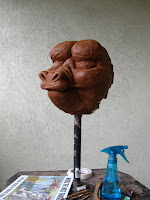
On to part two:
Once you have a pretty good shape sculpted for your mask in clay, you’ll want to cover the clay in tinfoil. This allows you to smooth out the surface, refine details, and allows for easier excavation once it comes time to finish the mask. Slightly crumple a large sheet of tin foil and press it down covering the entire surface of your mask. Use your sculpting tools to smooth out the bumps in the foil and to add stronger details. If a few spots of clay show through the foil it won't be the end of the world - just remember that the more you cover the easier it will be to remove the papier mache when it is dry.

Next you need to prepare the papier mache. This step is twofold. First, you'll want to prepare the paper bags. You can also use newspaper, but when making masks I prefer to use brown paper bags because they are stronger, require fewer layers, and generally are faster to apply. To make the bags easier to work with, I crumple them significantly. The point here is to start to break down the fibers of the bags so that they absorb more of the papier mache mixture and to make the bags more flexible so that they are able to fold around the shape of your mask. The image to the right shows three paper bags crumpled to varying degrees. Ideally, you want your bags to look like the last one on the far right - like an old map or a worn piece of fabric.

Now you're going to mix the papier mache glue mixture. I use about two or three large scoops of wheat paste with a few cups of warm water and then add wood glue until the mixture becomes the consistency of runny snot. When your mixture is ready you can start to cover the mask.
Make sure that you spray the foil covered surface with cooking spray before adding any of the papier mache -
otherwise you will not be able to remove the mask. Allow each piece of bag to soak in the glue mixture for about 30 seconds to one minute and wring out the excess glue before putting it on the sculpted form.

I try to use at least three layers of bags, sometimes a few more depending on the mask, before letting the mask dry. As the glue dries I like to refine the details even more (this is especially necessary if your mask has creases because the bags will pull away and flatten out as they dry - try and monitor the mask every few hours). The papier mache should take two to three days to dry completely though the outside should be dry overnight. However, even if the outside is completely dry, it does not mean that the inside will be too. I've had a few occasions when I've removed the mask too soon and it's shape will warp because the inside won't have anything to dry against. It is better to be safe here and wait a little longer.
Next up:
Removing the mask and adding finishing touches




















